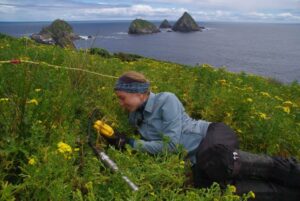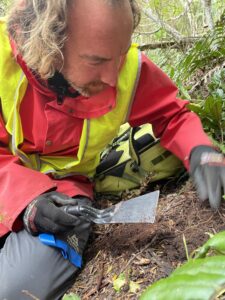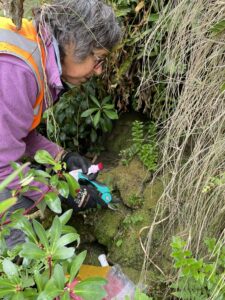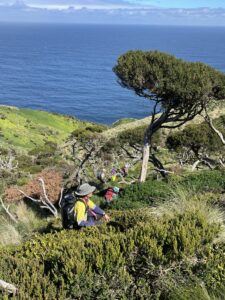WEED CONTROL SUCCESS ON MAATSUYKER ISLAND
Great outcomes for FOMIs Wildcare Tasmania weed control and shearwater monitoring 2021-2022 season have been achieved thanks to the terrific support over the past five years from the Pennicott Foundation www.pennicottfoundation.org.au.
- Jen – Weed team Maatsuyker Island – Photo by Marina Campbell
- Desley removing Hebe, Maatsuyker Island – Photo by Marina Campbell
This commitment and support from Robert Pennicott and the Pennicott Foundation has provided a significant boost to these programs.
The Weed Control program is in its eighteenth year and nearing the long-term objective to eradicate significant invasive species blackberry, Veronica (Hebe) elliptica, Montbretia and Californian Thistle.
The data demonstrate a continued reduction in active sites and numbers of weeds for each target weed species, with just 2 active Hebe sites (from a total of 307 recorded sites) with a total of 18 weeds removed; and 4 active blackberry sites (from a total of 183 recorded sites) with a total of 5 weeds removed. Of significance, these blackberry sites were all located in the area around the lightkeepers quarters with no blackberry located during field survey for the second season of working bees. For the Montbretia monitoring, weeds were present at 25 sites with a total of 384 weeds removed (a marked reduction in Montbretia from the 2020/21 season of 39 active sites and 1954 weeds removed); and there were no Californian thistle plants detected from the 1 known site.
The long-term Weed Control program is vital for ongoing restoration and maintenance of vegetation and seabird habitat values on Maatsuyker Island.
FOMI undertakes annual monitoring of the large Short-tailed Shearwater breeding population on Maatsuyker Island, with the 2021/22 season being the ninth season of monitoring. Burrow occupancy in December 2021 was 67.7 % which was above the average for nine seasons of data (62.3%). Breeding success (the number of pre-fledging chicks as a proportion of nests) was 75% which was above average for eight seasons of data (68%).



